Welcome to this special, free edition of Scheme Standouts. If this is your first Scheme Standouts, allow me to briefly explain what we do here. This is a weekly look at the five* most interesting play designs in college football. I clip the plays, diagram them and do my best to explain how they work, breaking them down as much as possible to make for easy consumption for fans who don’t spend their free hours studying coaching clinics.
Beyond the bare minimum, you aren’t going to get technical mumbo jumbo, coach phrases or anything else that normal college football fans don’t need in this spot. We’ll save that for the film study writers who I refer to colloquially as “playbook merchants.” This is college football film for college football fans, not coaches. Let’s go.
*rarely can I limit myself to five
~Key~ Yellow: Decoy/Blue: Block/Green: Route/Red: Designed ball carrier
TCU starts us off this week, making its first Scheme Standouts appearance of the season with a truly cruel play to call when up by 31 points well into the third quarter.
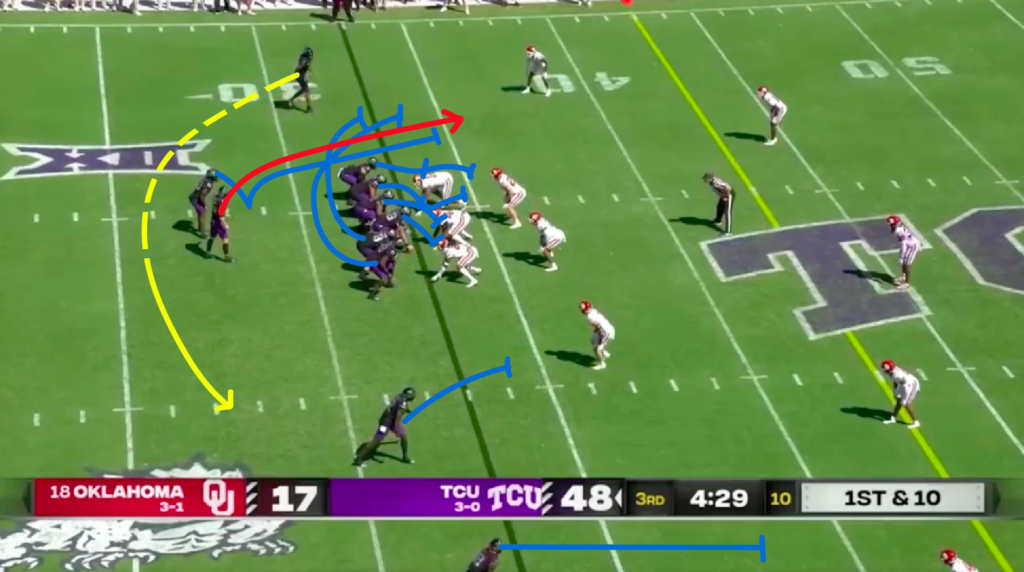
It’s a quarterback GT counter at its core, but the window dressing in the backfield is what makes the play work. TCU orbit motions the lone receiver lined in the boundary pre-snap, moving the cornerback across from him into the edge of the box, just outside of the hash marks.
This is important because the Horned Frogs are pulling their backside guard and tackle (hence the “GT counter” denomination). It’s the job of the former to hug the line as he pulls and wall off the edge defender, and it’ll be a lot easier to do that when the edge defender isn’t way the hell outside of the box. TCU is running the cornerback right into his blocker.
This motion does a little more than that, too. The overhang safety to the field isn’t likely to factor into this play regardless, but TCU can really make sure by holding him there with the threat of a swing pass – which TCU sells further by using the slot receiver as a seal blocker, just like it would for a swing pass.
While the guard pulls out to seal the edge and the tackle works around into the second (and eventually third) level, the left side of the line and an in-line tight end are dealing with Oklahoma’s five-man box. TCU has a hat on a hat for the nose tackle and backside defensive end with its center and left guard, while the tight end and left tackle need to contact and then reach off the playside end (meaning that they need to block him briefly, and then move past him) and into the second level to block the linebackers.
They exceed the expectations here and just about close out the box, giving TCU the pulling tackle and the halfback – who sold some counter action of his own before popping out into the boundary to help collapse those linebackers in – out in open space, leading the way for the least athletic 34-yard run of all time.
We look next to a pair of Clemson plays. If you’ve consumed this column or Flipping The Field before, you know how much it pains me to feature the Tigers. They are a program devoid of a soul and I would sooner cast them six feet into the dirt before I’d praise them.
However… these plays are cool. I can’t deprive you all of cool plays in service of my campaign to have Dabo Swinney indicted for his involvement in Jan. 6.
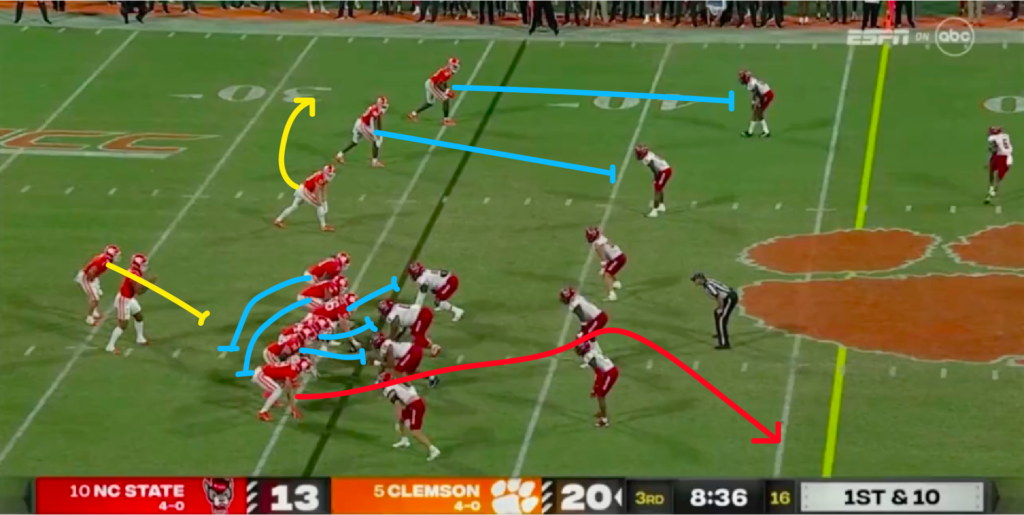
Clemson’s first look is a great little play action pass, designed to free up the in-line tight end on a corner route by hiding him with a bunch of backfield action. The Tigers sell an RPO GT counter to the boundary with a bubble screen from the field trips, a staple of the offense and something that N.C. State absolutely saw on film and prepared for.
You can tell just how much work N.C. State did on this, because every defender in the box reacts to this like they’ve undergone a week of GT counter RPO shock therapy. They swarm to fill their gaps, blowing up the spaces left by the pulling linemen and overwhelming the six-man front for what should be an easy TFL.
This six-man front dwindles to five without the Wolfpack ever noticing, as the in-line tight end slips out into open field for an uncovered corner route. D.J. Uiagalelei gets the ball out just before the pressure arrives, and Clemson has a wide-open completion and a big gain thanks to very good self-scouting and a tendency breaker.
This second play carries with it a similar ethos and is again able to beat N.C. State by using its preparation against it.
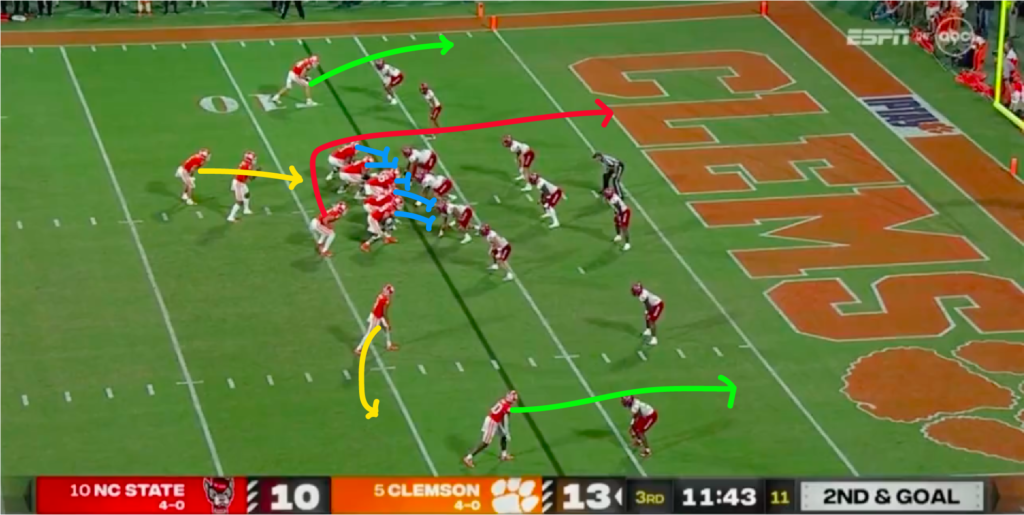
It’s another play designed to mimic an RPO staple, this one being split zone with a bubble screen tag to the field. The offensive line blocks down across the board, as it would on split zone, while the H-back slices behind them – presumably to take on the edge defender, which would be the outside linebacker in the case.
The box again collapses on what it expects to be an inside handoff. One defender, the box safety, realizes what’s going on as the H-back slips past his blocking assignment and cuts upfield into the seam. But, he’s too far out of position and too small to handle the back shoulder throw that follows.
Alright, let’s wash that taste out of our mouths with a program of the proletariat – Illinois, making its second Scheme Standouts appearance of the season.
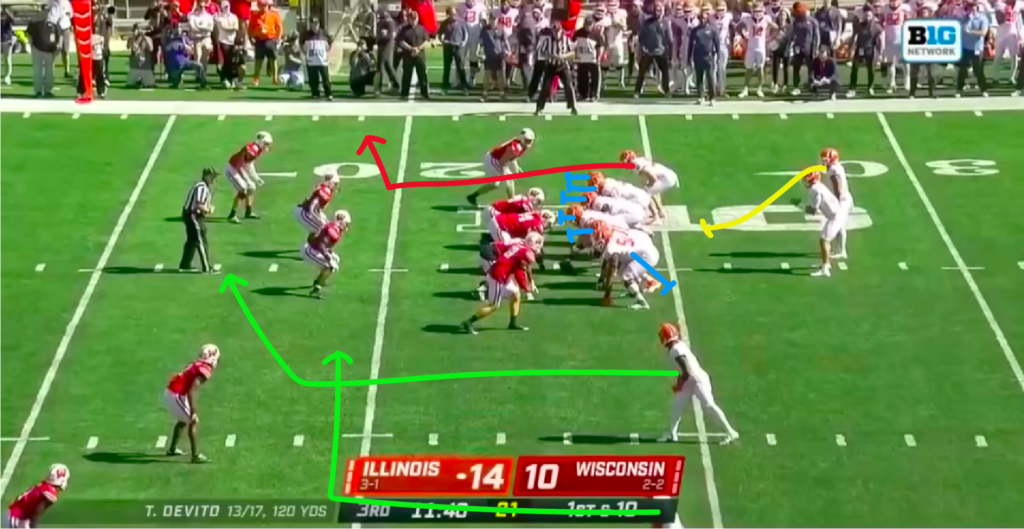
This is a lot like Clemson’s TE corner play action, though Illinois is selling inside zone and a glance RPO to the field rather than counter with a screen tag. The idea is the same – draw an overly aggressive box in with the run fake while sneaking a tight end out into open space.
The glance action from the field (this is just fancy talk for the slant from the slot) is especially important here because of the boundary safety. Illinois knows it can draw the linebackers in with the run fake, and it does not need to worry about the field cornerbacks, but that safety is accountable for the offset tight end running the corner route. It would take some excellent coverage, but he could jump this one if the Fighting Illini don’t have something to distract him.
Like, for example, a slant directed at him and an inside release from the tight end he needs to cover. He’s left on an island, and this route starting in before breaking out to the sidelines is enough to freeze him. Tommy DeVito has an easy throw and Illinois has a first down.
We have another returning champion here, and another strong representative of Midwestern excellence. Kentucky has long held a place in my heart for its creative power rushing attack, and it rolls out a great little wrinkle here to punish a defense leaning on tendencies. Stop me if this sounds familiar. I’ve said before that themes seem to develop naturally in this article, and the theme this week seems to be tendency breakers.
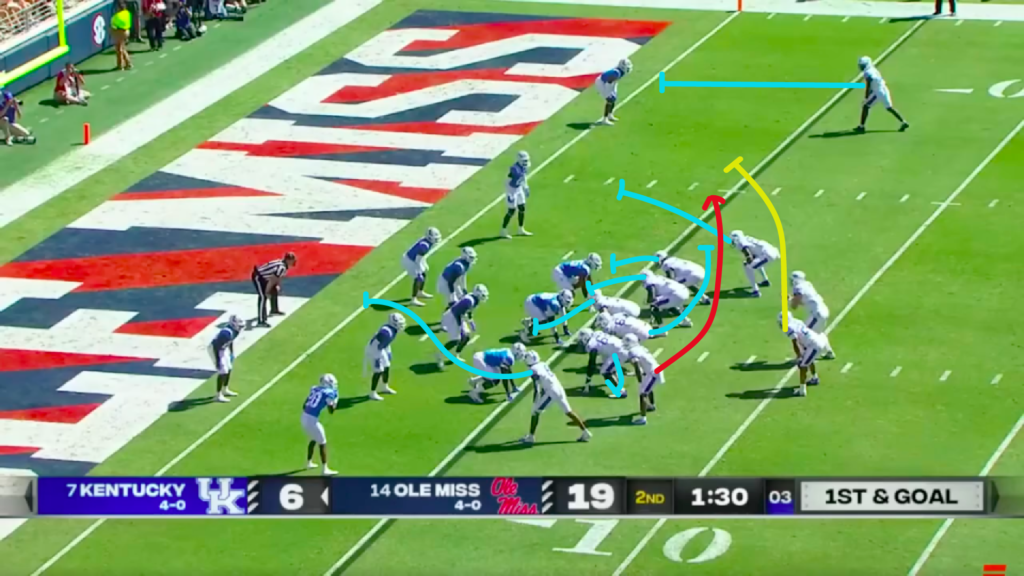
This looks exactly like Power, one of Kentucky’s favorite run concepts. The backside guard is pulling to lead the way with some help from a playside tight end for an outside handoff to the halfback. The formation is a little funky, almost a proto-wishbone, but Ole Miss knows what this is as soon as it sees the pulling guard. It spent the last week practicing against this play from every imaginable formation.
And indeed, Will Levis sells a handoff to the halfback after the snap. Ole Miss defenders need not think anymore about it, this is Power and they know how to play Power. They need to get horizontal and beat halfback Chris Rodriguez to his cut upfield, which will usually come right around the far hash mark.
Kentucky wants to take advantage of this pursuit, tucking a run inside of the pulling guard and tight end into what should be empty space and the Rebel defenders continue their horizontal pursuit. It could do this with a quarterback keeper, as you would on inverted veer, but wideout Tayvion Robinson is quite a bit quicker than Levis and can tuck into a small space. Levis sells the fake handoff and flicks out a shovel pass to Robinson, who was lined up as the backside slotback and tracked with the play – hiding behind the line as he did so.
Ole Miss actually has a defender who is a bit behind here and who nearly blows up the play on accident, but Robinson is good enough to improvise, breaks free of that defender and follows his blockers – of which there are now three with Rodriguez unencumbered by ball carrying duties – into the end zone.
The Kansas Korner
For those of you new to the show, I’ll offer a tiny bit of background here. The Kansas Korner is a weekly look at whatever cool shit Lance Leipold is dialing up in Lawrence. It exists because Kansas has been on this damn thing every week of the season, and I can’t make the Jayhawks the focus of almost half of the five plays every time I do this column. Thus, The Kansas Korner was born.
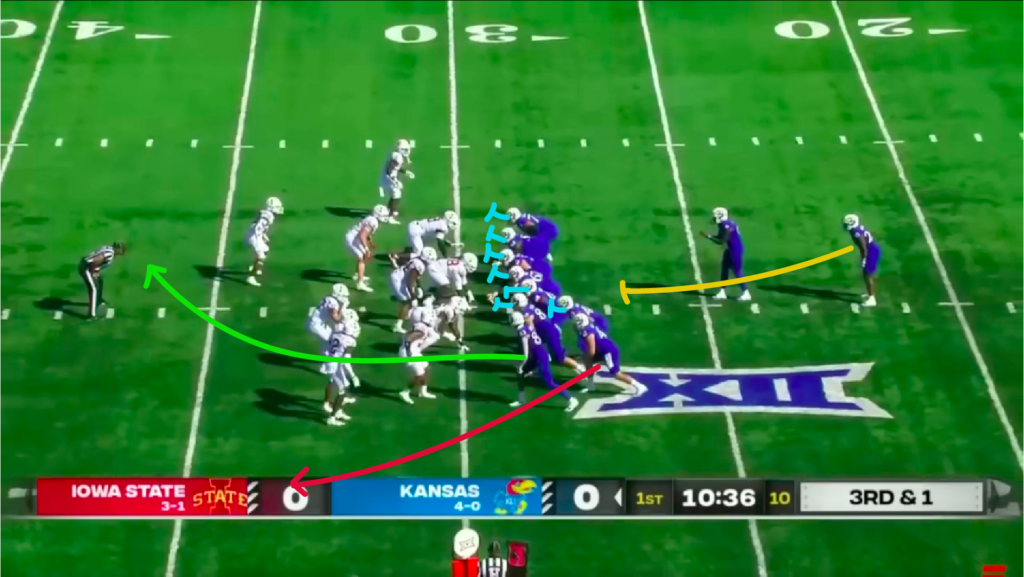
If this week’s theme isn’t tendency breakers, it has to be play action passes to a hidden tight end. Kansas lines up with a truly despicable formation – pistol with two in-line receivers and two offset H-backs behind them all bunched in the boundary – and already has Iowa State off-balance for it.
On the snap, Jalon Daniels sells an inside zone play fake, with the offensive line and the inside stack of the bunch blocking down to the field and the handoff portending to cut against that.
Iowa State thinks, as any sane defense would, that this play includes seven blockers, and that Kansas is planning to run to the D gap – outside of the inside stack, while the outside stack leads the way. It reacts accordingly, with all three linebackers collapsing to fill inside gaps while a pair of defensive backs set up in the outside gaps, the point man setting the outermost edge and the corner immediately behind him filling in the D gap.
The outside stack breaks into a post/wheel combo, with the point receiver drawing the lone coverage defender on his post and the H-back trailing him taking a horizontal step to sell the blocking before breaking into a wheel down the sidelines. Iowa State is dead before the ball leaves Daniels’ hand.
You like that formation weirdness? Buddy, I’ve got just the play for you as we close this thing out.
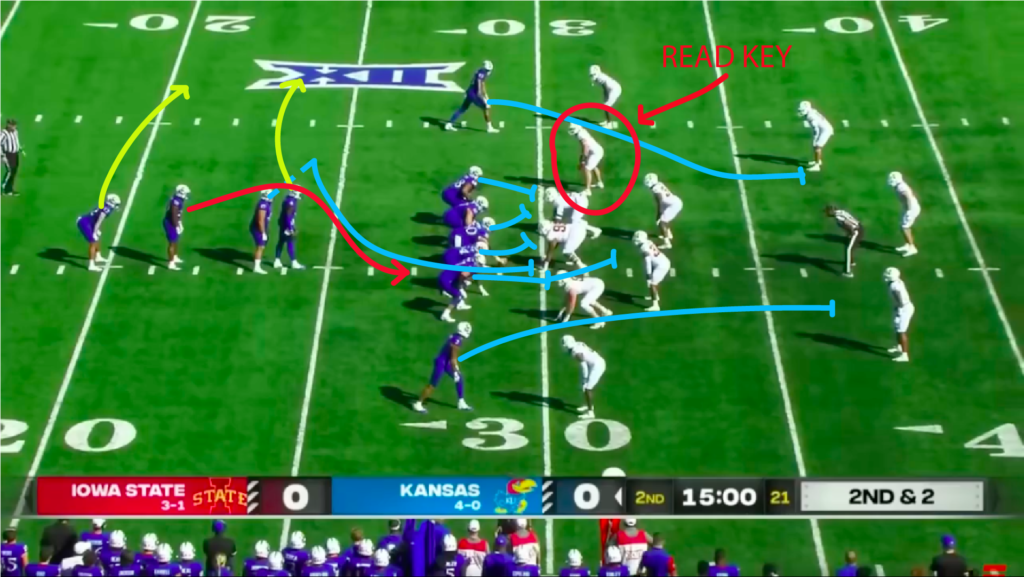
Kansas comes out in a pistol Maryland I-formation (30 personnel) and five down linemen, with one receiver to either side of the field. Daniels motions the fullback to his side and snaps the ball immediately, giving that fullback some momentum to sell his counter action. His first step goes outside as if he’s preparing to block the outside linebacker to the field as he would on a load option (a sprintout for Daniels with a pitch option to the deep back). That’s there to alter the first steps of the linebackers, and more importantly, to hold that outside linebacker in his place.
He needs to be there because Daniels is going to read him. This turns into a triple option play, and if the linebacker sits, Daniels is going to hand it off to the closer of two halfbacks. If he bites in, Daniels pulls the ball and goes into the aforementioned load option, at which point his read becomes the outside cornerback as the receiver to the field looks to reach the field safety.
The linebacker does stick around, so Daniels hands the ball off and this becomes a trap run. Kansas doesn’t have to worry about the outside linebacker, so it doubles the field defensive end with its tackle and center, takes out the nose tackle with a down block from the right guard and gives the right tackle a reach assignment, clearing out the remaining defensive end and then moving into the second level as a lead blocker.
Those inside blocks hold steady, and the right tackle reaches off, passing the defensive end to the pulling backside guard. The halfback trails his fullback into an interior gap, and has lead blocks from the right tackle and boundary receiver to follow as he gets into the second level.
Don’t ever let anyone tell you that programs like Iowa, Stanford or Wisconsin need to modernize their offense by moving on from heavy sets and power looks. You don’t need four-wide sets to be modern. You just need clever design, and Kansas has it in spades.
